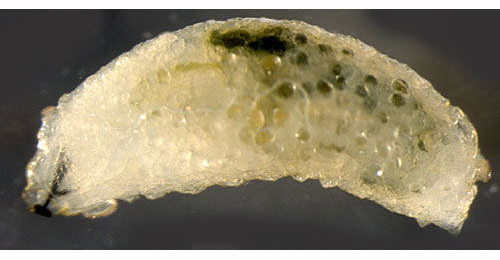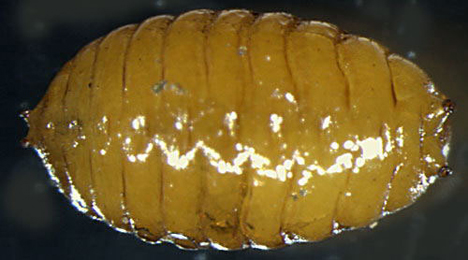|
||||||
| Aulagromyza
hendeliana (Hering, 1926) [Diptera: Agromyzidae] |
|||||||||||||||||||||||||||||||||||||||||||||||||||||||||||||||||||||||||||||||||||||||||||||||||||||||||||||||||||||||||||||||||||||
|
Phytagromyza
hendeliana Hering, 1926b. Dt. ent. Z. 1925(5):
380 |
|||||||||||||||||||||||||||||||||||||||||||||||||||||||||||||||||||||||||||||||||||||||||||||||||||||||||||||||||||||||||||||||||||||
|
Leaf-miner: A long conspicuous white linear mine. Pupation external (Spencer, 1976: 315, 317 (fig. 565)). An upper-surface corridor that widens only a little, and generally is unbranched. Often a part of the corridor loosely follows the leaf margin. Frass in two neat rows of grains or short thread fragments. Pupation outside the mine. Feeding punctures in the lower surface (always?) (Bladmineerders van Europa). An upper surface gallery with frass in large, well-spaced grains (British leafminers). Larva: The larvae of flies are leg-less maggots without a head capsule (see examples). They never have thoracic or abdominal legs. They do not have chewing mouthparts, although they do have a characteristic cephalo-pharyngeal skeleton (see examples), usually visible internally through the body wall. Posterior spiracles of larva (and puparium) without horn within ellipse of spiracular bulbs (British leafminers). The larvae was described by de Meijere (1949), Dempewolf (2001: 164) and in Bladmineerders van Europa.
Puparium: The puparia of flies are formed within the hardened last larval skin or puparium and as a result sheaths enclosing head appendages, wings and legs are not visible externally (see examples). Yellowish; posterior spiracles with 20 minute bulbs, without a horn-like process (Spencer, 1976: 315). The puparium is illustrated in British leafminers and Bladmineerders van Europa.
Hosts in Great Britain and Ireland:
Hosts elsewhere:
Time of year - mines: June-October. Time of year - adults: Currently unknown. Distribution in Great Britain and Ireland: Common in southern England (Spencer, 1972b: 65) Records include Warwickshire (Packington) (Robbins, 1991: 106), Hampshire (Fleet) (British leafminers) and Rum (Bland in Whiteley, 1994), Caernarvonshire, Caitheness, Cambridgeshire, East Gloucestershire, East Norfolk, East Ross, East Suffolk, East Sutherland, Easterness, Elgin, Glamorgan, Huntingdonshire, Isle of Wight, Leicestershire, Main Argyll, Mid Perthshire, Mid-west Yorkshire, North Ebudes, North Wiltshire, Pembrokeshire, Shropshire, South Lancashire, South-west Yorkshire, Stafford, Surrey, West Gloucestershire, West Kent, West Norfolk, West Suffolk and Westmorland (NBN Atlas). Also recorded in the Republic of Ireland: Co. Clare, Co. Cork and Co. Galway (Spencer, 1972b: 65) and National Biodiversity Data Centre Map). Distribution elsewhere: Widespread in much of Europe, including Denmark, Finland, Norway, Sweden (Spencer, 1976: 315), Netherlands (Bladmineerders van Europa), Germany (Spencer, 1976: 562; Dempewolf, 2001: 164), French mainland, Lithuania, Poland, Spanish mainland and Switzerland (Fauna Europaea). NBN Atlas links to known host species:
British and Irish Parasitoids in Britain and elsewhere: |
| Last updated 09-Jul-2019 Brian Pitkin | ||


